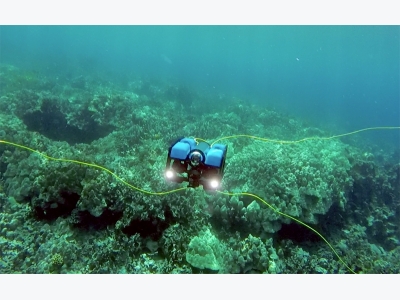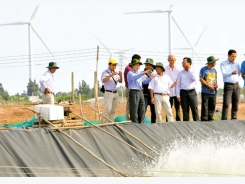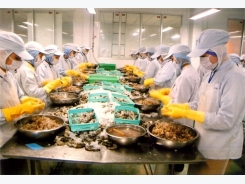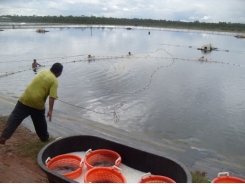Drones making waves in aquaculture

Flying drones are revolutionizing land-based businesses, with realtors taking aerial photos of for-sale houses, and retailers exploring drone-based delivery systems.
A similar revolution could be on the horizon for aquaculture, with underwater drones giving fish-farmers eyes under the waves, allowing them to monitor water conditions and fix equipment problems cheaply.
Instead of delivering packages, these underwater drones will measure dissolved oxygen levels and other physical and chemical information, according to drone builders. And they’ll be equipped with cameras to spot tears in nets before they grow too severe.
Such inspections can be dangerous for divers, Rusty Jehangir, the founder of Blue Robotics, which sells underwater drones and parts, told SeafoodSource.
“It’s a tedious task and it takes a long time. With an ROV (remotely operated vehicle), you can do it a lot quicker. You can get into the water, and out, and move on to the next one,” Jehangir said.
Jehangir started Blue Robotics in 2014 out of the back of his garage. At the time, he was working in aerospace, had recently learned to surf and had a friend also interested in robotics. The pair decided to see if they could send an old surfboard rigged with solar panels, a GPS system and electric motors across the Pacific to Hawaii – and do it for under USD 1,000 (EUR 942).
During online research, they came across many other people pursuing similar ventures in robotics and ocean-going drones. But they quickly ran into a wall that others before them had faced: they couldn’t find affordable thrusters.
So, they decided to build their own. They patented the design, and targeted the product at the low-cost hobbyist community.
To grow from experimental to mass market – as airborne drones did in just a couple years – affordable parts are key. Blue Robotics aims to fill that niche, building low-cost parts that can be ordered online and shipped the same day.
“Other companies haven’t really caught on to that. They’re using technology they developed years ago,” Jehangir said.
Blue Robotics also sells an ROV for USD 3,500 (EUR 3,299). In addition to the in-house thrusters, open-source autopilot software helps keep costs down.
“Now that the price is coming down, it becomes a possibility,” Jehangir said. Fish farmers “are very driven by their bottom line, so spending USD 100,000 (EUR 94,000) on an ROV to inspect nets on a farm – that’s just unreasonable … We’re trying to be a big part of that change by providing an ROV that’s much lower cost.”
Future farm mechanization – accomplished through drones and a host of other emerging technologies – won’t resemble the past, according to Christophe Pelletier, an expert on the future of food.
Previously, mechanization and automation essentially added muscle to tasks that required brute force: increasing the ability to lift more, carry more, do more. Drones are part of that future upgrade, but other technologies will play a big role, too.
“The thing for the future is really much more about the combined use of technologies such as drones, sensors, robotics, artificial intelligence, augmented reality, software development and big data,” Pelletier told SeafoodSource.
Combining all those technologies brings about much more progress than each individual technology does alone. Such a combination of technologies behaves like a nervous system, Pelletier said.
But the first step for fish farmers is just sensors in the water, Tyler MacCready, the CEO of Apium, a drone maker that specializes in swarms of drones, told SeafoodSource.
“If you want to know what is going on out there, you have to have the sensor out there where the ocean is. You can’t really remote sense chemistry measurements,” MacCready said.
MacCready envisions his drones mapping ocean currents, temperatures, dissolved oxygen and salinity – all useful information for fish farmers. The drones could even monitor conditions in a fish pen while the fish are in it feeding.
“With a lot of these sensing vehicles moving around in a pen full of fish, you can really know what is gong on while you’re interacting with them, feeding them, harvesting them,” MacCready said.
Related news
Tools

Phối trộn thức ăn chăn nuôi

Pha dung dịch thủy canh

Định mức cho tôm ăn

Phối trộn phân bón NPK

Xác định tỷ lệ tôm sống

Chuyển đổi đơn vị phân bón

Xác định công suất sục khí

Chuyển đổi đơn vị tôm

Tính diện tích nhà kính

Tính thể tích ao




 More shrimp farming cooperatives meet ASC standards
More shrimp farming cooperatives meet ASC standards  EMS-ravaged shrimp sector bounces back in Belize
EMS-ravaged shrimp sector bounces back in Belize